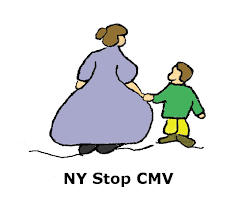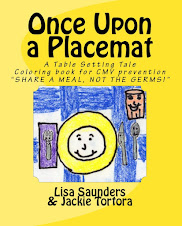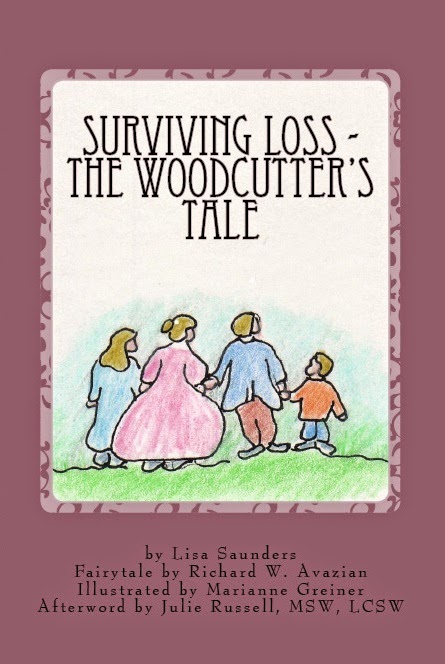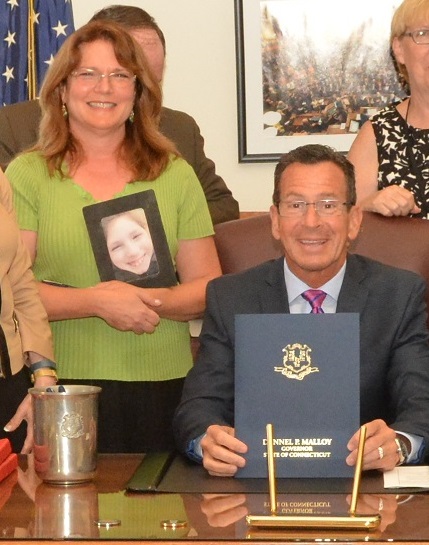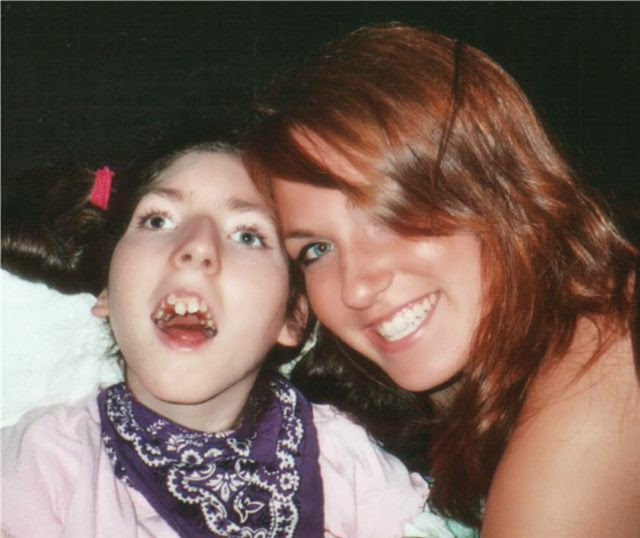Pregnant women love to hear they shouldn't be changing the
kitty litter, but will they love to hear the inconvenient truth about
something else they shouldn't be doing? That there is another infection that
needs to be avoided when pregnant--one that causes more
disabilities than Down syndrome?
Congenital CMV (cytomegalovirus) is the number one viral
cause of birth defects, yet few women have heard of this common virus. Why?
Because few peope want to tell them they can catch it from their beloved
toddlers--that the very act of kissing them on the mouth may just be the kiss
of death and/or disability for their unborn child.
I’m a mother who didn’t know about CMV prevention until it
was too late for my daughter Elizabeth (I ran a daycare center for young
children and had a toddler of my own). Elizabeth was born severely disabled by
congenital CMV in 1989. The moment I saw her, I felt a stab of fear— her head
was so small, so deformed. The neonatologist said, “If she lives, she will
never roll over, sit up or feed herself.” He was right. By her 16th birthday,
Elizabeth had survived several bouts of pneumonia, seizures and major
surgeries. Weighing only 50 pounds, she looked odd to strangers, but her
cheerful, soul-capturing smile made her lovely to my husband and me. Two months
later, she died during a seizure.
I am the parent representative of the Congenital CMV
Foundation and have spoken at two international Congenital CMV Conventions
organized by the Centers for Disease Control and Prevention (CDC). After my
first talk in 2008 in Atlanta, GA, mothers approached me afterwards holding
their young children wearing hearing aids, or pushing them in wheelchairs. They
all wanted to know the same thing: "Why didn’t my OB/GYN warn me about
CMV?"
Fewer than half (44%) of OB/GYNs surveyed by the American College of
Obstetricians and Gynecologists (ACOG) in 2007 reported having counseled their
patients how to prevent CMV infection despite these figures from the CDC:
• Every hour, congenital CMV causes one child to become
disabled
• Each year, about 30,000 children are born with congenital
CMV infection
• About 1 in 750 children is born with or develops permanent
disabilities due to CMV
• About 8,000 children each year suffer permanent
disabilities caused by CMV (See: http://www.cdc.gov/cmv/index.html).
According a 2006 survey reported in the article, "Knowledge and Awareness
of Congenital Cytomegalovirus Among Women," of the 643 women surveyed
about their CMV awareness, only 22% had heard of it and most of those could not
correctly identify modes of CMV transmission or prevention.
Why don't OB/GYNs routinely warn their patients? An OB/GYN
quoted in FitPregnancy magazine (June/July '08) said, "The list of things
we're supposed to talk about during women's first visit could easily take two
hours and scare them to death.”
In addition, many OB/GYNs don't realize the prevalence of congenital CMV. In the article, “Washing
our hands of the congenital cytomegalovirus disease epidemic,” Drs. Cannon and
Davis state: “The virtual absence of a prevention message has been due, in
part, to the low profile of congenital CMV. Infection is usually asymptomatic
in both mother and infant, and when symptoms do occur, they are non-specific,
so most CMV infections go undiagnosed.”
"Primary
infection during pregnancy accounts for over 90% of severely affected babies
and approximately 75% of women with a primary infection during pregnancy
acquire CMV from their own child under two years of age,” said Stuart Adler, M.D., Professor of
Pediatrics, Microbiology and Medicine and Director of Infectious Diseases at
the Children’s Medical Center, Virginia Commonwealth University Medical Center.
Dr. Adler has specialized in CMV infections among women and children for over
28 years and has published extensively on this topic.
Despite these
statistics, according to the CDC, "CMV does not spread easily. Less than 1
in 5 parents of children who are shedding CMV become infected over the course
of a year...In the United States, approximately 30-50% of women have never been
infected with CMV. About 1-4 of every 100 women who have never been infected
with CMV have a primary (first) CMV infection during pregnancy. About one third
of women (33 of every 100) who become infected with CMV for the first time
during a pregnancy will pass the infection to their infant."
The direct costs of
caring for CMV-disabled children are estimated at $1-$2 billion annually.
Between 50% and 80% of adults in the U.S. are infected with
CMV by 40 years of age. During pregnancy, there are steps one can take to
reduce changes of contracting CMV, such as talking to your doctor if you expect
to receive a blood transfusion. Most blood banks don’t screen blood for CMV.
Daycare workers and
mothers of young children should take these special precautions:
- wash
your hands thoroughly after contact with urine or saliva
- avoid
oral contact with saliva or objects covered with saliva (such as cups,
pacifiers, toys, etc.)
- talk
with your doctor about whether you should continue to work in a day care
center.
- 4. Clean toys, countertops, and other surfaces that come
into contact with children’s urine or saliva
I am asking the public for advice on how I can reach people
who work in daycare centers or have a child enrolled in one. Some centers post
flyers mentioning the need for careful hygiene when working with young
children--but not many. Until OB/GYNs (and pediatricians) make it a standard
practice of care to educate women of childbearing age on CMV prevention, I feel
the public needs to do something.
Mothers of children affected by congenital CMV are so upset
the medical community didn't find a way to warn them of the precautions to take
so they could make up their own minds if they still wanted to share a mouth
kiss with their toddlers or work in daycare centers with children under the age
of two and a half. I believe knowing the precautions to take after wiping a
runny nose or picking up toys covered in saliva can help prevent the kind of
suffering my daughter Elizabeth endured.
The medical community is working on a vaccine and there is also a study
currently underway to see if receiving CMV hyperimmune globulin (HIG) will prevent
congenital CMV infection. They are looking for women who would like to be tested for the disease.
I
received the following e-mail from the Study Chair for a 14-center NICHD
Maternal Fetal Medicine Units Network (MFMU) randomized clinical trial testing
the efficacy and effectiveness of hyperimmune globulin for prevention of
congenital CMV in women with primary infection:
Cytomegalovirus (CMV) is the most common congenital
infection, with a prevalence of approximately 1% in the United States,
translating into 44,000 congenitally infected infants per year. A substantial
proportion of these 44,000 infants will die or suffer permanent injury as a
result of their infection. The severity of congenital infection is greatest with
primary maternal CMV infection.
Currently, there is no
proven method of preventing congenital CMV infection, and the approach to
primary maternal CMV infection in the United States is haphazard and
ineffective. One small, non-randomized study suggests that
maternal administration of CMV hyperimmune globulin may reduce the rate of
congenital CMV infection following maternal primary infection.
or contact:
Brenna Anderson, M.D.,
M.Sc.
Women & Infants Hospital
of RI
101 Dudley
Street
Providence, RI
02905
401-274-1122 ext.
7456
For more information about congenital CMV:
An article written by doctors I found very enlightening:
I am listed on the Congenital Cytomegalovirus Foundation site along
with the doctors who specialize in Congenital Cthey are all willing to speak to
you. Their e-mail address is linked to their name: http://www.congenitalcmv.org/foundation.htm
About me, Lisa Saunders:
Lisa Saunders lives in Mystic, Connecticut, with her husband and beagle/basset hound. A Cornell University graduate, Saunders is the parent representative of the Congenital CMV Foundation and speaks at international congenital CMV conferences ('08,'12) sponsored by the Centers for Disease Control and Prevention (CDC), Congenital CMV Foundation, and the National Congenital CMV Disease Registry. Most recently, she spoke at a conference sponsored by the Infection Control Nurses of Connecticut (April '13). Lisa is a consulting writer for Rockland Community College of New York, part-time history interpreter at Mystic Seaport, and the author of several books, including her humorous and touching memoir about her CMV-disabled daughter growing up beside her tomboy sister and a lazy, old devoted canine, Anything But a Dog! The perfect pet for a girl with congenital CMV. the book includes interviews with the country's leading congenital CMV experts and raises funds for CMV research and parent support if purchased through the The National Congenital CMV Disease Registry and Research Program. Saunders also raises congenital CMV awareness in her humorous and historical book, Mystic Seafarer's Trail, where she reveals her desire to become thin and famous like Amelia Earhart so people will listen to her CMV prevention message. In an effort to share the comfort she received from her father's fairytale after her daughter died from complications of congenital CMV, she also published Surviving Loss: The Woodcutter's Tale, which, in addition to raising congenital CMV awareness, includes comments on grieving from a licensed clinical social worker (it's available as a free e-book at: https://www.smashwords.com/books/view/283862


